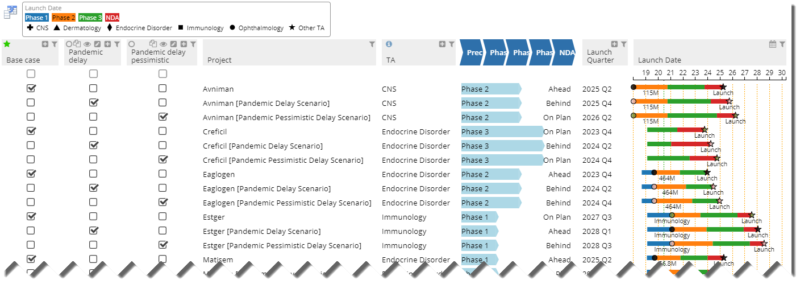
The COVID-19 pandemic has brought severe disruption to many industries, including drug development and medical device companies. All businesses face uncertainty about the return to normalcy—and what normal will even look like going forward. For some industries, the new normal might look very different. For others, like pharma and medical devices, the new normal may not require as much change. In fact, some signs of a return to normal are already appearing: Clinical trials are starting to resume. Demand for non-COVID 19 drugs and medical devices is rising again as routine medical care returns. The key uncertainty for these companies is in the timing of return to normal and the rate at which it will happen.
In times like these, when uncertainty is the only sure thing, portfolio management is more important than ever. One pharma company’s story shows how portfolio management can help you plan through the unknowns of the pandemic and continue to manage through it, even as those unknowns evolve. It illustrates how portfolio management can be used to accommodate disruptions, whether internal or external, that impact the company’s ability to deliver.
The company, which we will refer to as Enlighten Pharma, Inc., (Enlighten) is a mid-sized pharmaceutical company with a drug development pipeline focused on three major therapeutic areas. It has a well-established portfolio management group that coordinates the portfolio activities across distinct stakeholder groups such as program management office, finance, and commercial forecasting, with an eye towards achieving the long-range strategic goals set by management. The year 2020 was an important one for Enlighten, with upcoming launches in 2021 to 2023, including a first-in-class candidate. With the onset of the COVID-19 pandemic, the critical Phase 3 trials as well as other trials were experiencing delays or put on hold entirely. With significant uncertainty about the magnitude and extent of the pandemic, the portfolio team set about to assess the impact on their upcoming planned launches as well as on the short to mid-term cost and revenue projections. The following sections describe the steps they took and the resulting insights that helped them navigate the crisis.
Note: To protect the client’s confidentiality, all data and images in this post are from a demo system. The visuals are, however, representative of the visual and analytical tools used by the client.
Take Stock of the Situation
The first thing Enlighten did was to assess the current state of its portfolio. This was easier to do because they already had an inventory of all their initiatives—a single source of truth for the key data related to all its initiatives.
They had been using the Enrich Analytics Platform for some time. As a result, the leadership team knew the current status of each initiative, as well as its upcoming milestones and expected launch date. The system had also captured—and made easily available—the external development costs and internal FTE requirements by phase for each project, as well as the revenue forecasts and corresponding financial assumptions. Taken together, these data gave the team a complete picture of each project and its planned development schedule.
Figure 1: Pipeline overview with relevant asset information. The drilldown shows a detailed launch timeline along with other key information about the project.
You don’t need every last piece of data to benefit from portfolio analysis. It helps to have all your initiatives in one place with the minimum set of data you need to support the decisions you need to make. Portfolio management takes less data (and effort) than you think. Read more ici.
Create Scenarios to Explore the New Reality
To assess the impact of pandemic-induced delays on the portfolio, the management team asked each project team to update development plans over a period of three weeks. Known delays in clinical trials were captured and subsequent development plans adjusted to reflect the new dates. When trial resumption dates were uncertain, the teams came up with a best-guess scenario—the team’s best guess, most-likely estimate for when trials might resume—and a more pessimistic, worst-case scenario. These paired scenarios provided visibility into three possible outcomes for each project:
- Base case: The base-case assumptions prior to the pandemic
- Pandemic Best-Guess Delay Scenario: Best-guess scenario for pandemic-induced delays
- Pandemic Pessimistic Delay Scenario: A scenario positing longer delays
The project teams also estimated shifts in development costs and revenue driven by the delays, providing visibility into the pandemic’s impact on both financial requirements and revenue. This collection of data provided the management team with a relatively complete impact assessment.
Figure 2: Base case with two delay scenarios, showing delay in Phase 3 start due to COVID-19 related disruptions in Phase 2 clinical trials. Mapping two delay scenarios allows the capture of a range of possible outcomes for the project. Launch is delayed by 6 and 12 months, respectively, in the delay and pessimistic delay scenarios.
Figure 3: Development cost in the base case vs. the two delay scenarios. Due to the delays, the costs are both shifted out and spread over more years in the delay scenarios compared to the base case.
Figure 4: Revenue in the base case vs. the two delay scenarios. Due to the delays, the revenue realization is later in the delay scenarios than in the base case.
If you’re in cost-cutting mode, your scenarios might be based on different levels of cost cutting, rather than on different delay lengths. Asking your teams to estimate project outcomes for different levels of investment will let you pick the best alternatives at the portfolio level. The key is to periodically revisit the initiatives and question the assumptions behind them to make sure they are still valid in the new circumstances. Create alternate scenarios that reflect the new reality—and its new outcomes. Read more about scenario planning ici and see it in action with Enrich Analytics Platform ici.
Plan/Act
Armed with this information, management was prepared to answer critical questions: what will the delays mean for the pipeline, how they will impact spending in the coming year, what impact they will have on near-term revenue, and how to ameliorate the impact on the most strategically important projects.
What Do Delays Mean for Anticipated Pipeline Milestones and Launches?
Figure 5: Comparing risk-adjusted launches using the different delay scenarios built by the project teams. Base case represents expected launches based prior to pandemic impact; pandemic delay scenarios show expected launches under the two delay scenarios modeled by the project teams. Each bar represents portfolio-level totals,created by summing across all projects included in the particular scenario.
To answer this question, which was important both for internal planning and for investor communications, the analysts created three portfolio-level scenarios:
- Base case: Scenario built on base-case assumptions for each active project
- Pandemic delay: Scenario built on best-guess delay assumptions
- Pandemic delay pessimistic: Scenario built on pessimistic delay assumptions
Summing up the risk-adjusted launches in each scenario provided three possible outcomes. The analysts could have created additional scenarios that mixed base-case and either best-guess or pessimistic delay scenarios for different projects. But these three scenarios provided book-ended views of the range of possible outcomes.
The comparative views showed no impact on current-year launches. However, in 2021, expected launches fell by nearly half. In years 2022 through 2025, spillover impacts from the delays persisted; in the pessimistic delay scenario, new launches peak in 2024.
How Will Pandemic Delays Affect Spending This Year and Budgeting for Next Year?
Figure 6: Impact of delays on risk-adjusted development costs. Each bar represents portfolio-level totals, created by summing across all projects included in the scenario.
To understand the pandemic’s effect on current-year spending and near-term budgeting, the analysts aggregated risk-adjusted development costs in the three portfolio scenarios. That exercise showed current-year development costs 10%–20% lower than the base-case assumption. In 2021, the reduction is even higher, in the range of 25%–50%. From 2022 onward, the difference from base case starts to shrink, with development costs increasing each year as trial activities resume and the slack is picked up.
To successfully execute the projects, managing demand for internal FTEs is also key. As new projects compete with delayed projects for FTEs, demand for some roles may exceed the supply. If shortfalls are not managed proactively, the overall throughput of the portfolio will be decreased. Read more about strategic resource planning ici et ici.
What Impact Will Delays Have on Near-Term Annual Revenues?
Figure 7: Impact on portfolio revenue. Each bar represents portfolio-level totals, created by summing across all projects included in the scenario
To understand the effect of pandemic delays on the company’s revenue stream, the analysts aggregated risk-adjusted revenue forecasts across all initiatives in each of the three portfolio scenarios. This analysis revealed that the impact on 2020 and 2021 expected revenue was not noticeable. However, the effect grew from 2022 onward, creating a deficit of up to 40% in the outer years. With this knowledge in hand, the management team acted on two fronts: the company is looking for acquisition deals to fill the revenue gaps and looking at its own initiatives with an eye toward accelerating strong candidates to realize the revenue sooner.
How Will Pandemic Delays Affect the Most Strategically Important Projects, and What Can Be Done to Ensure Resources for These Projects?

Figure 8: Comparing delay scenarios across projects provides clear visibility into strategically important initiatives.
The portfolio-wide view allowed the analysts to see which initiatives will be vying for resources once trials resume. This survey allowed analysts and management to identify the initiatives that provided first-in-class benefits and make sure those projects had priority for resources—protecting the company’s competitive advantage. Fortunately, competitors’ trials were also delayed. Prioritizing key initiatives in this way will leave the company better positioned than competitors who don’t have the same portfolio view and can’t be as proactive in responding to the situation.
Shortcuts to Modeling Portfolio-Wide Impact
How can you generate scenarios to accomplish what Enlighten did? In an ideal situation, you may be able to ask your project teams to create alternate project-level impact scenarios. However, that may not always be possible; project teams may not have the bandwidth to create detailed scenarios for each project. However, you may be able to get away with a quicker approach to modeling portfolio impacts. Creating high-level scenarios for the projects at the portfolio level using levers can provide just enough information. Levers are essentially multipliers on quantities such as revenue and development costs or whole numbers specifying delays, for instance in phase start dates, in months.
To use this approach, you still have to have all your initiatives and the relevant information about each one in a single place. But instead of building detailed scenarios for each project, you can quickly model the impact on specific projects or sets of projects by delaying activities or phases across the set and assessing the cumulative impact of those delays on subsequent phases, launches, and financial outcomes. Or you can reduce estimated development costs across a set of projects by a set percentage and examine the impact on your annual budget. Similar assessments can be done for revenue forecasts, probability of success, or any other major source of uncertainty.
This approach, although not as accurate as a detailed project-level scenario, still provides a directionally correct answer to some big what-if questions and a rough assessment of the magnitude of the impact on the portfolio.
Figure 9: Using time levers to model delays (here in months) in the start of specific phases for specific projects. Levers allow rapid assessment of the impact of delays on the overall portfolio, without the need for detailed scenario building for each project.
Closing Remarks
This case study demonstrated a scenario-based approach to modeling key uncertainties and using the resulting scenarios to make portfolio-level assessments and decisions. In this case, the key uncertainty was the timing of the resumption of clinical trials and the objective was to assess the impact of delays in trials on launches, development costs, and revenue across the portfolio. The company created models by asking project teams to create two delay scenarios for their projects, a best-guess scenario and a pessimistic scenario. The portfolio team then aggregated the scenarios across all projects to measure the portfolio-level impact. This process allowed the company to proactively communicate the impact of pandemic-induced delays to investors and create strategies to address anticipated revenue and resource gaps. It also positioned the company to ensure its strategically important initiatives have the resources they need to move forward when trials resume. Portfolio-level assessment enabled these insights and decisions.
Alternate approaches to assessing the impact of disruptions are available. One approach, discussed here, relies on a high-level what-if analysis to quickly create rough, but directionally correct, portfolio-wide scenarios. In a probabilistic approach, delays are modeled as probability distributions across a range of possible delays. Sampling that distribution provides a distribution of launches, development costs, and revenue given a specific delay. Decision makers can then use the expected values or other percentiles from those distributions to decide on a course of action.
Regardless of the specific approach, the key is to revisit all of the initiatives in the portfolio, reevaluate the assumptions underlying them in the context of the new circumstances, create alternate scenarios that reflect the new reality, and then assess the impact of the disruption at the portfolio level to inform your decisions. Looking for help to improve your companies’ scenario planning capabilities? Contact us!
How does the method I’ve outlined compare with your firm’s decision making process? Let me know in the comments!












